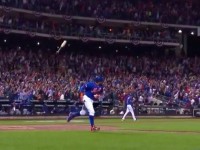
Man today’s players just don’t respect the game or their opponents. Years ago, they never would’ve celebrated on the field:
Yes, that’s Kirk Gibson celebrating a homerun off of Goose Gossage. That was from the 1984 World Series. You know what I couldn’t find anywhere? Gossage condemning Gibson for the celebration. Sure, it would seem like sour grapes, but he had a platform then and didn’t use it.
Now? Well now, the Hall of Famer rails against how players today celebrate. He called Jose Bautista and Yoenis Cespedes and their celebrations to be an embarrassment and disgrace to the game. He’s apparently taking issue with the bat flips:
Gossage comes off like an old man lamenting how things were better in his day. He is remembering the days when if you hit a homerun, you put your head down and rounded the bases. No one out there showed any emotion so as to not show anyone up. They knew if they did the pitcher was going to stick one in your ear. The thing is that he has selective memory. Additionally, times have changed.
In an ESPN the Magazine interview with Tim Keown, Bryce Harper shared his thoughts on player celebrating on the field:
Baseball’s tired. It’s a tired sport, because you can’t express yourself. You can’t do what people in other sports do. I’m not saying baseball is, you know, boring or anything like that, but it’s the excitement of the young guys who are coming into the game who have flair. If that’s Matt Harvey or Jacob deGrom or Joc Pederson or Andrew McCutchen or Yasiel Puig — there’s so many guys in the game now who are so much fun.
Jose Fernandez is a great example. Jose Fernandez will strike you out and stare you down in the dugout and pump his fist. And if you hit a homer and pimp it? He doesn’t care. Because you got him. That’s part of the game. It’s not the old feeling — hoorah . . . if you pimp a homer, I’m going to hit you right in the teeth. No. If a guy pimps a homer for a game-winning shot . . . I mean — sorry.
If a guy pumps his fist at me on the mound, I’m going to go, ‘Yeah, you got me. Good for you. Hopefully I’ll get you next time.’ That’s what makes the game fun.
Overall, Harper’s thoughts represent a a change in the culture of baseball.
Players today are more apt to celebrate on the field. Their celebrations are more elaborate. When these celebrations happen, players seem to take it the same way Heyward says he takes it.
Sure, there are current players who feel differently than Bautista, Cespedes, and Heyward. Apparently, there were people like Kirk Gibson who felt differently than Goose Gossage when it came to celebrating a homerun back in the day when Gossage pitched.
If this is the current culture of the sport, we should all accept it. As long as these bat flips don’t result in players getting plunked, who are we to judge? In fact, what Harper states is that the celebrations fuel him to get the pitcher the next time. If these celebrations are both fun and bring out the best in everyone on the field, how can this be anything but good for baseball?
For baseball’s part, they seem to be embracing it showing the bat flips in commercials and putting them on YouTube. Baseball is going it because the culture has changed from the time Goose Gossage has played the game. Players want to celebrate, and fans want to see it.
The culture of baseball has changed whether or not the Goose Gossages of the world approve.
Editor’s Note: this article first appeared on metsmerizedonline.com
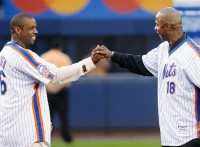
Growing up, my favorite player was Darryl Strawberry. My brother’s was Dwight Gooden. Both were addicted to drugs. Both ruined their careers over it. Both forced my father to talk about it with my brother and I as these issues arose. I remembered that yesterday when reading Jared Diamond’s Tweet:
https://twitter.com/jareddiamond/status/707919767391309824
I have to be honest. Thoughts like this can keep me up at times at night. With my son being two, I fortunately will not have to answer questions like this for quite a while. However, there will come a day I will have to answer these questions.
Where to begin?
Well, first off, I think it’s not just a father-daughter question. I think it’s a father-child question. Additionally, I think it’s an opportunity for a parent. It’s a teachable moment. It’s a time to address not just the acts and ramifications, but also why a player like Aroldis Chapman is still allowed to play baseball.
In having this discussion, the overriding principle should be honesty.
I would start with how a man should never ever lay his hand on a woman. A man should never ever physically threaten or denigrate a woman. Those are not the actions of a real man. I never have and never will treat his mother like that. I expect he will never treat a woman that way.
I would then explain that he was punished for his actions. No, I don’t agree with the suspension. I thought he got off easy. With that said, he was punished for his actions, and it did cost him about $1.7 million. It has also damaged his reputation. Wherever he goes for the rest of his life, he’s going to be associated with these actions.
As for why he’s still allowed to play? It’s twofold. First, he served a suspension, and he’s allowed to return. And yes, he should be allowed to return. Chapman deserved his suspension. He served his punishment. Anytime anyone serves their punishment, they have a right to return. They have a right to turn their lives around. Chapman is no different.
I’d also point out the obvious. Chapman is playing because he can throw 100 MPH. No one would want him if he wasn’t uniquely talented. It’s why he’s getting a second chance. It’s why someone will always be interested in giving him a chance. It will never excuse what he did, but when you are great at something someone will always give you a chance. With that said, in anything you do in life going forward, always be cognizant that one mistake or one action can take everything away no matter how great you are.
The most difficult question to answer is why would I root for him. You see I don’t root for him. I root for the Mets. I root for the Mets because I always have through thick and thin. I root for the Mets like my Dad does. The Mets are more than just one player. Sure, there will always be a player or two I don’t like. There may be a player that has done something as vile as what Chapman did. No, I don’t like having a player like Chapman on the Mets, but I don’t get a say in who plays for the Mets.
So yes, it’s alright to root for the Mets. It’s alright to cheer when someone like Chapman helps your team. I just wouldn’t buy his jersey or cheer him when he’s announced.
At least this is what I hope I will do.

With the Mets young staff poised to led them to yet another postseason appearance, and God willing, another World Series, I’m reminded of all the pitchers who have started a postseason game for the Mets. Can you name them? Good luck!
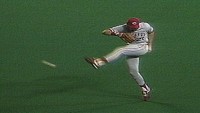
“Dad, who did you vote for in the Republican primary?”
“I voted for Donald Trump.”
“Why Dad?”
“Well son, Paul O’Neill endorsed him.”
In my life, I have honestly never come across someone who voted for a candidate because a baseball player or other celebrity endorsed that person. However, that still didn’t stop the outrage.
Some people are apoplectic that this happened. Doesn’t he know what Trump stands for? Doesn’t he know Trump’s policies? How could Paul O’Neill possibly have endorsed Donald Trump? I’m sure there are also people who are commending O’Neill for understanding why the country needs to elect Trump.
For all the uproar, I haven’t seen one interview with O’Neill questioning him why he endorses Trump. I’m sure he can provide a cogent argument for his decision. As I’m sure Johnny Damon could as well for why he has endorsed Trump.
With that said, I’m not making my decisions based upon that. I’m not going to let O’Neill’s endorsement affect the way I think about him as a player or the election. To me, he will always be the player who Armando Benitez couldn’t strike out. He’s the guy who once kicked the ball into the infield while he was in Cincinnati.
I encourage everyone to get involved and make their own decisions even if the my disagree with mine. Although, I wish you would agree with me. Watch tonight’s debate. Research the candidate’s history and what they believe.
Don’t support a candidate based upon your favorite player. Don’t let a player’s endorsement let you affect what you think of that player. If you’re a Yankee fan, you should adore O’Neill for all that he’s done. As a Mets fan, tip your cap to him for having the at bat that might’ve altered the course of the entire World Series.
I don’t watch baseball to get into endless political debate. People don’t listen to Mark Levin or watch Rachel Maddow to get their take on the Mets chances this year. People need to compartmentalize.
I’m moving on now and ignoring who any future athletes endorse.
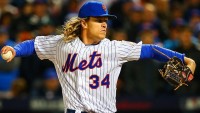
Going into the 2016 season, there is one fear each and every Mets fan has. We dare not speak its name, but that doesn’t change the fact that it’s still present. That fear is that a pitcher will get seriously injured.
Looking at this year’s list of pitchers who could befall the dreaded “Verducci Effect,” Noah Syndergaard headlines that list. If Syndergaard was to suffer a season ending injury requiring Tommy John surgery? it would greatly hinder the Mets chances of winning not only the World Series, but also making it to the postseason. It’s something that not just Mets fans fear, but as Anthony DiComo of MLB.com reports, Syndergaard fears it also:
I’ve thought about it quite a bit. But I trust myself to put my body in the right situations to be able to perform at a healthy level.
The fear is justified. Syndergaard threw 65.2 innings more last year. He throws over 95 MPH more than anyone in the game. He’s working to add the fabled Warthen Slider to his already dominant repertoire. Name a risk factor for UCL years requiring Tommy John surgery. Syndergaard meets most if not all of them.
One risk factor not readily discussed is the team he plays for. Look at the projected Mets rotation when healthy: Matt Harvey, Jacob deGrom, Noah Syndergaard, Steven Matz, and Zack Wheeler. Put aside Syndergaard for a moment. What do the other four have in common? They are all hard throwing pitchers under the age of 30 who have already had Tommy John surgery.
Go outside this group. Since Warthen took over as the Mets pitching coach, the following homegrown Mets have sustained arm injuries: Jon Niese (shoulder), Dillon Gee (shoulder), Jeremy Hefner (two Tommy John surgeries), Rafael Montero (shoulder), Bobby Parnell (Tommy John), Josh Edgin (Tommy John), Jack Leathersich (Tommy John). There are more, but you get the point.
Now, is this an organizational problem since Warthen took over, or is it just bad luck? Could this all have been avoided? Back in the 60’s and 70’s the Mets developed pitchers like Tom Seaver, Jerry Koosman, Nolan Ryan, and Jon Matlack. These pitchers threw more innings than the pitchers today, and yet, Matlack was the only one of this group that suffered an arm injury.
In the 80’s, the Mets had Dwight Gooden, Ron Darling, Sid Fernandez, Rick Aguilera, Randy Myers and David Cone. Of this group, only Doc and Cone had arm issues. It should be noted that Doc had many other issues as well, and Cone’s problem was an aneurysm later in his career.
In the 90’s, Generation K was a bust, and the Mets haven’t developed the caliber of starting pitchers like they have in the past until now. However, this generation seems to befall injuries far more often than their predecessors. Is it organizational? Is it bad luck? Is it preparation? For his part, Harvey wonders what if:
I think now, there are things I could have done better in high school or in college to maybe prevent it. But I don’t know. I’m not saying [Syndergaard] works that much harder than everybody else, because we all work hard. I think as time progresses, guys pay more attention to stretching the shoulder, strengthening the shoulder. If I could go back — I don’t know if this would’ve prevented me from having [surgery], but if I could go back and really do 20 extra minutes of stretching and arm care, you never know what could happen.
That’s the thing. We really don’t know why one guy suffers elbow and shoulder injuries while others don’t. Is it preparation? Is it good genes? Is it just good luck? Much time, energy, and money has been spent on this issue, and yet pitchers still get injured. Pitchers get injured despite teams doing everything in their power to try to prevent it.
It will help Syndergaard being in a clubhouse with players who have had Tommy John surgery. They each will have advice for him on why they suffered the injury and what they could’ve done differently. More importantly, Syndergaard appears to be a hard worker who takes the health of his arm very seriously. There is no doubt he is doing everything he can do to avoid the dreaded Tommy John surgery.
Based on what we’ve seen, if anyone can avoid it, it’s him.
Editor’s Note: this article was first published on metsmerizedonline.com

Excuse me for a moment. I’m going to rip a page right out of the script from A Time to Kill:
I want to tell you a story. I’m going to ask you all to close your eyes while I tell you the story. I want you to listen to me. I want you to listen to yourselves. Go ahead. Close your eyes, please. This is a story about a Mets pitcher. He comes to Spring Training after a big year, and he is upset with his contract. He wants to get paid what he thinks he deserves, but he is forced to accept what the Mets give him. In his first Spring start, his velocity is down. He’s unhappy with his contract, and he still has more work to do in Spring Training to get ready for the season. Can you see him. I want you to picture that Mets pitcher. Now, I want you to imagine he’s Jacob deGrom.
Look, everyone assumes it’s Matt Harvey who is going to be difficult to agree to a contract extension. It’s his off-the-field social life that gets highlighted, and for some, it creates the presumption that he does not do all he can do to be prepared for the 2016 season.
However, this Spring Training, it’s been deGrom who has complained about his salary, which is something Harvey didn’t do. He was the Mets pitcher that went out his first start and didn’t have people espousing that he’s in mid-season form.
Note, this is definitively not a criticism of deGrom. He has done nothing to deserve criticism. I take no umbrage with him wanting to get paid what he thinks he’s worth. I applaud him wanting to sign an extension to stay with the Mets. I will not read anything into one Spring Training start. So far in his young career, deGrom has been ready to pitch when called upon.
It should also be noted Harvey has also stated he would be open to signing an extension to stay with the Mets. Of course when Harvey says it, people are dismissive of the concept. The real difference between Harvey and deGrom is perception.
With the innings limit drama last year, deGrom is seen as a team first guy, and Harvey is seen as a me first guy. I’m not sure that characterization is entirely fair. Harvey pitched all postseason, and he never asked out of a game. Rather, he wanted the ball.
The Mets are blessed to have three aces. They all want to win, and they are doing what is necessary to win a World Series. Let’s just enjoy them instead of creating narratives that they don’t want to be here, or that they only care about themselves.
It’s not fair, and it’s not right. It’s time for Mets fans to press the reset button on their relationship with Harvey.

There are no dumb questions. In some respects, the question itself is more enlightening than the answer itself.
That is the case with Matt Harvey being asked if “he can finally just be a ‘regular guy’ again.” That’s a loaded question. Does this mean him being a regular guy like you or me (or you)? Does this mean him being just one of the guys in the clubhouse? Does this mean Harvey returning to his old self after his first complete year back from Tommy John? Seriously, it’s a loaded question.
The fact of the matter is Harvey will never be just a “regular guy.” He’s been a lightning rod. He was the first pitcher called-up. He gave Mets fans hope. He started an All Star Game, had an incredible 2013, and pitched that incredible World Series game. His innings and starts have been an issue. He’s got a boisterous agent and a high profile off the field. So no, Harvey never was and never will be a regular guy.
That’s a good thing.
At his core, Harvey is an ace. Aces are cut from a different material than the rest of us. They go to the mound with a certain swagger that some would call arrogance. His lone job is to get you out. It’s not a problem for him because he’s better than you are. He believes each pitch has a purpose. Each pitch is unhittable. His mindset is important. His stuff puts him on a different level than everyone else.
So no, Harvey is not a regular guy. I wouldn’t have it any other way.

So far, the big Matt Harvey story of the preseason is the return of his vaunted slider. According to Harvey, he did not have it for most of last year.
For what it’s worth, Spring Training is always full of stories pumping up players. Every player appears to be in the best condition of their life. Players are healthier than they have ever been in their career. They’re either ready to build upon a strong season or put a tough season behind them. Does the supposed return of Harvey’s slider fit into that catergory?
In 2013, Harvey’s breakout season, he was 9-5 with a 2.27 ERA, 0.931 WHIP, 157 ERA+, 2.01 FIP, and a 9.6 K/9. He threw his slider 18.5% (504 total) of the time. Rather than try to explain how his slider moved, here’s a two graphs from Brooks Baseball showing the vertical and horizontal movement of Harvey’s 2013 slider:

 When Harvey threw his slider, it was swung at 49.01% of the time. When batters swung at the pitch, it was fouled off 15.8% of the time. It generated a swing and miss 17.66% of the time, and it was put into play 16.88% of the time. When contact was made, it typically generated a groundball. He only allowed two homeruns off of the pitch. In sum, it was a terrific pitch for him.
When Harvey threw his slider, it was swung at 49.01% of the time. When batters swung at the pitch, it was fouled off 15.8% of the time. It generated a swing and miss 17.66% of the time, and it was put into play 16.88% of the time. When contact was made, it typically generated a groundball. He only allowed two homeruns off of the pitch. In sum, it was a terrific pitch for him.
Now, if we use Harvey’s word that his slider didn’t return until the last quarter of the season, it means he didn’t have his slider until August. Again, using Brooks Baseball, here are graphs showing the vertical and horizontal movement of Harvey’s slider:


Taking a cursory look, Harvey’s slider had less horizontal and vertical movement. Unsurprisingly, the pitch was not as effective for Harvey.
From April to July, Harvey threw this slider less frequently than his old slider. His slider usage rate dropped from 18.5% to 15.12%. During these months, Harvey relied much more heavily on his fastball. Part of the reason for that might’ve been his lack of confidence with his slider.
When Harvey did throw his slider, it was swung at 43.92% of the time. When batters did swing at the pitch, they fouled it off 9.12% of the time, swung and missed 17.57% of the time, and put it in play 17.57% of the time. While the new slider did generate more groundballs, it did also generated less swings and misses.
More importantly, it needs to be reiterated that Harvey did not have the confidence in this pitch that he did in 2013. To an extent, it changed what he was as a pitcher, and the results showed. From April until July, Harvey went 9-7 with a 2.91 ERA, 1.06 WHIP, and an 8.5 K/9.
Harvey said he found his slider sometime in August. Here’s how his slider moved from August through the postseason:
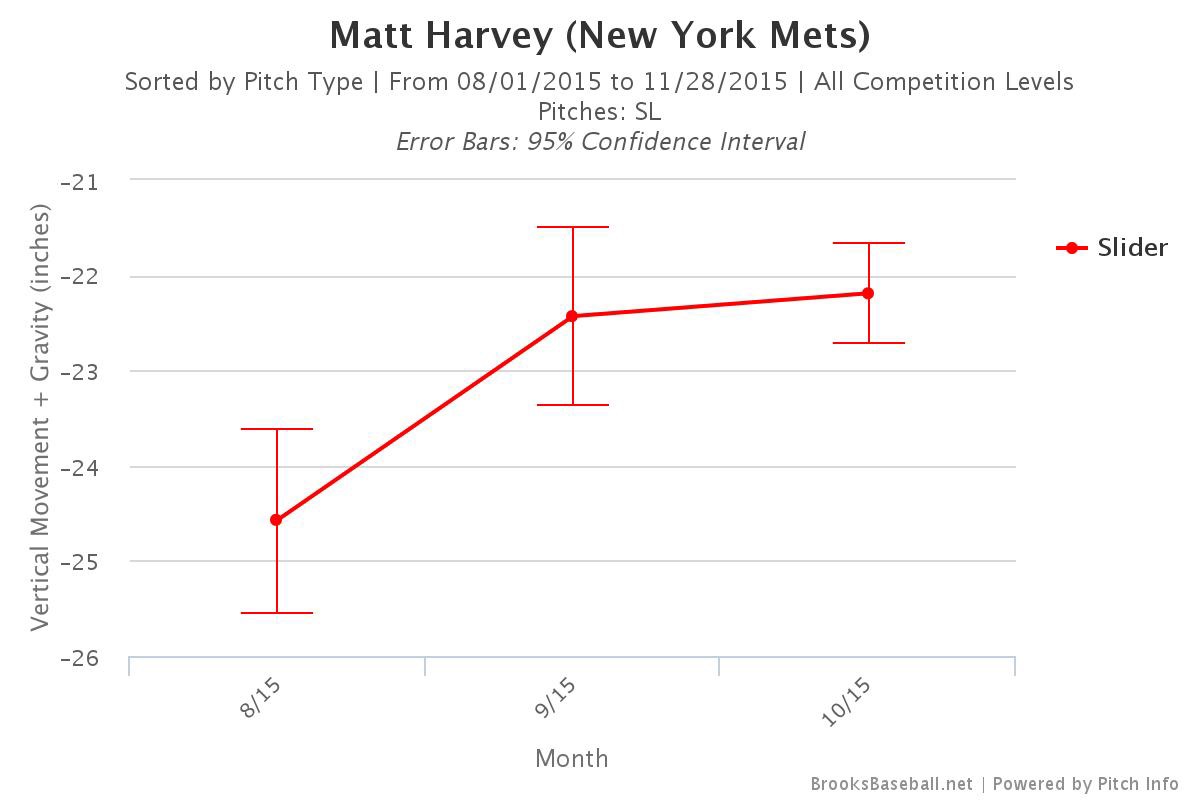
 Looking at the charts, Harvey’s slider appeared to get its movement back, especially in August. What is surprising is that Harvey used his slider even less frequently than he had done in the first five months of the season. His slider usage rate dropped to 13.10%.
Looking at the charts, Harvey’s slider appeared to get its movement back, especially in August. What is surprising is that Harvey used his slider even less frequently than he had done in the first five months of the season. His slider usage rate dropped to 13.10%.
When he did throw it, it was more effective. Batters swung at the slider 53.03% of the time. When batters did swing at the pitch, it was fouled off 15.91% of the time, swung and missed 18.94% of the time, and put in play 18.94% of the time. Harvey’s rediscovered slider was able to generate a similar percentage of groundballs as he had between April – July.
To close out the regular season, Harvey was 4-1 with a 2.24 ERA, 0.927 WHIP, and a 10.1 K/9. While we should always be careful of drawing conclusions from short sample sizes, it appears that the 2013 Cy Young caliber version of Harvey is back.
Judging from Harvey’s first Spring Training start, he still has his slider. With that, Harvey should have increased confidence, and more importantly better stuff out there in the mound. Now that the slider will be back for a full season, Harvey is back in the Cy Young discussion (if he ever left), and he is primed to dominate the National League.
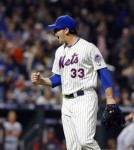
In 2015, Matt Harvey became the pitcher who has thrown more innings than any other pitcher post-Tommy John surgery. In fact, he became only the fifth pitcher to throw more than 200 innings in the first year post-Tommy John surgery. The other four are:
- Tommy John 207.0 IP
- Jake Westbrook 202.2 IP
- Adam Wainwright 213.2 IP
- John Lackey 215.1 IP
Last year, Harvey had a very good year in his first year back. In determining how next season will go, we should look to these other four pitchers as they are the only other pitchers who have thrown as many innings as Harvey has after Tommy John surgery.
Tommy John
As we all know, Tommy John was the first pitcher to return from Tommy John surgery. Obviously, he had a successful return as physicians have continued to perform the surgery to resuscitate pitchers’ careers.
In 1974, John’s last season before surgery, he went 13-3 with a 2.59 ERA and a 1.144 WHIP. He had a 2.74 FIP and a 132 ERA+. He only lasted 22 starts throwing 159.0 innings before shutting it down, having the sugery, and missing the 1975 season.
In 1976, John returned to the Dodgers. He went 10-10 with a 3.09 ERA and a 1.295 WHIP. He had a 3.08 FIP and a 109 ERA+. He made 31 starts and threw 207.0 innings. He returned, and he was able to pitch. However, he did not pitch nearly as well as he had prior to the surgery.
In 1977, John returned to form. He was 20-7 with a 1.248 WHIP. He had a 3.05 FIP and a 138 ERA+. He made 31 starts throwing 220.1 innings. He finished second in the Cy Young voting. He was better than he was pre-surgery.
With Tommy John, we saw a pitcher get better the second year after his surgery. Also, looking over the rest of his career, John was able to pitch until he was 46 years old. Accordingly, we can reasonably conclude that the 200 innings post-surgery did not negatively impact his career. We can also reasonably conclude that John was better and stronger than those 200+ innings.
Jake Westbrook
In 2008, Westbrook was only able to make five starts before needing Tommy John surgery. In 2007, his last presumably healthy season, he pitched 152.0 innings going 6-9 in 25 starts with a 3.12 ERA, 1.408 WHIP, 4.33 FIP, and a 105 ERA+.
From 2004-2006, Westbrook had pitched over 200 innings in each season with an ERA+ ranging from 93-127. In the 2004-2007 timeframe, Westbrook had a 91.69 MPH fastball, 81.69 MPH change, 80.55 MPH curve, and an 88.40 MPH cutter.
When Westbrook returned from surgery in 2010, he threw 202.2 innings over 33 starts between the Indians and the Cardinals. He had a 4.22 ERA, 1.337 WHIP, 4.22 WHIP, and a 93 ERA+. Upon his return, he threw a 91.07 MPH fastball, 79.63 MPH change, 83.56 MPH slider, 79.78 MPH curve, and an 86.07 MPH cutter.
The following season, Westbrook made 33 starts pitching 183.1 innings. He went 12-9 with a 4.66 ERA, 1.533 WHIP, 4.25 FIP, and an 80 ERA+. He had a 90.76 MPH fastball, 80.22 MPH change, 79.52 MPH curve, 86.44 MPH cutter.
Westbrook’s career would only last two more seasons. He never again reached 200 innings in a season. He didn’t have the rebound Tommy John seemed to have, but then again, Westbrook was never the pitcher John was.
Adam Wainwright
In 2010, Wainwright went 20-11 with a 2.42 ERA, and a 1.051 WHIP in 230.1 innings. He had an ERA+ of 160 and an FIP of 2.86. He was an All Star, finished second in the Cy Young voting, and was a top 20 MVP candidate. He would also need Tommy John surgery after this season.
Before the surgery, Wainwright’s repertoire included a 91.73 MPH sinker, 83.56 MPH change, 74.69 MPH curve, and a 86.44 MPH cutter. With this repertoire, he had consecutive seasons of 200+ innings pitched, 19+ wins, and a sub 2.65 ERA.
After rehabbing during the 2011 season, Wainwright returned to throw 213.2 innings between the regular season and playoffs. Wainwright would go 14-13 with a 3.94 ERA and a 1.248 WHIP in 198.2 innings in the regular season. He had a 96 ERA+ and a 3.10 FIP. He returned with a 90.70 MPH sinker, 84.25 MPH change, 74.50 MPH curve, and an 86.07 MPH cutter.
The following year, Wainwright seemed to return to his pre-Tommy John form. He was 19-9 with a 2.94 ERA and a 1.068 WHIP. He led the league with 241.2 innings pitched. His ERA+ was 127, and his FIP was 2.55. He threw a 92.08 MPH four seamer, a 91.06 MPH sinker, 84.56 MPH change, 76.12 MPH curve, and an 88.60 MPH cutter. He was an All Star, a Gold Glover, a top 20 MVP candidate, and he finished second in the Cy Young voting.
Wainwright followed this up with a strong 2014. He would miss most of 2015 with a torn Achillies. Like Tommy John, he was a much better pitcher the second year after Tommy John surgery.
John Lackey
There was a time it was thought that Lackey forgot how to pitch when he signed a contract with the Red Sox.
In 2009, Lackey’s last year with the Angels, he was 11-8 in 176.1 innings over 27 starts. He had a 3.83 ERA, 1.270 WHIP, 115 ERA+, and a 3.73 FIP. He threw a 92.11 MPH four seamer, 91.83 MPH sinker, 85.68 MPH change, 82.68 MPH slider, and a 79.37 MPH curve.
Interestingly in the two years prior to his surgery, Lackey threw a 92.06 MPH four seamer, 91.42 MPH sinker, 84.83 MPH change, 85.53 MPH slider, and an 80.02 MPH curve. He went 26-23 with a 5.26 ERA, 1.504 WHIP, 82 ERA+, and a 4.21 FIP. While he made 33 starts pitching 216.0 innings in 2010, he was only able to make 28 starts while pitching 160.0 innings in 2011.
In 2013, he returned to throw 215.1 innings between the regular season and postseason. In the regular season, he was 10-13 in 29 starts throwing 189.1 innings. He had a 3.52 ERA, 1.157 WHIP, 117 ERA+, and a 3.86 FIP. He threw a 92.64 MPH four seamer, 92.04 MPH sinker, 84.19 MPH change, 86.28 MPH slider, and an 80.33 MPH curve.
Lackey followed this up with a strong 2014. In 2014, he pitched 198.0 innings going 14-10 in 31 starts between the Red Sox and Cardinals. He had a 1.278 WHIP, 102 ERA+, and a 3.78 FIP. He pitched an additional 13.1 innings in the postseason giving him 213.1 innings total. He threw a 92.7 MPH four seamer, 92.24 MPH sinker, 84.43 MPH change, 84.49 MPH slider, and a 79.10 MPH curve.
Lackey had an even better 2015. Like John and Wainwright, Lackey got better the second year away from Tommy John. As such, in three of the four test cases, pitchers who threw 200 innings in the first year post Tommy John improved the second year after surgery.
Matt Harvey
Matt Harvey has thrown more innings than any other pitcher who has had Tommy John surgery. He’s also the youngest of the group, and he throws the hardest.
In 2013, Harvey was the All Star Game starter and an early Cy Young candidate. In the abbreviated season, he finished fourth in the Cy Young voting. Before he was shut down, he went 9-5 in 26 starts pitching 178.1 innings. He had a 2.27 ERA, 0.931 WHIP, 157 ERA+, and a 2.01 FIP. His FIP lead the league. Before he was shut down, he threw a 96.63 MPH four seamer, an 87.79 MPH change, a 90.50 MPH slider, and an 84.25 MPH curveball.
When Harvey returned, he threw a 96.46 MPH four seamer, 88.78 MPH change, 90.24 MPH slider, and an 84.35 MPH curveball. So, Harvey did return with similar velocity than he had before the surgery. That may be, in part, due to the fact that he had about 18 months of rehab as opposed to the year of rehab he predecessors had.
In the regular season, Harvey pitched 189.1 innings in 29 starts. He went 13-8 with a 2.71 ERA, 1.000 WHIP, 136 ERA+, and a 3.05 FIP. Looking over these numbers, Harvey’s stuff might’ve returned, but he still had a period of adjustment. While he had respectable numbers, he did not produce results similar to what he did in 2013. By judging by the previous pitchers, we can reasonably expect Harvey to return to his 2013 levels.
So overall, now that he has a year under his belt, and he has his full arsenal at his disposal, Matt Harvey is primed to have a Cy Young caliber 2016.
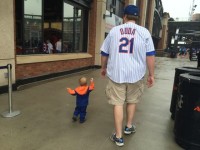
When you take your child to the ballpark, you have one overriding goal, and that is to keep your child safe.
Keeping your child safe starts with your choice of seats. By their nature, kids have short attention spans. With the proliferation of smartphones, they’re even shorter. With balls and bats flying into the stands, you put your child in danger if you sit too close to the field:
I don’t blame an excited kid for sending his mom photos from the game. I blame his father for getting seats way too close to the field.
Despite what some people have to say, this is an important issue. Just because some reporters or official scorers do not pay attention to every pitch, it doesn’t mean other fans don’t. I know I do . . . except when I’m at a game with my son.
When I’m at a game with my son, I’m constantly distracted. I’m getting him something to eat or drink. I’m going to the FanFest area. I’m describing to him what is going on during the game. He wants to know when Mr. Met is coming. He wants me to pick something up off the floor. He’s showing off how he can use the cup holders. He wants to give me a high five. He wants a hug. He wants a homerun. Basically, he wants attention.
My eyes are away from the action more than I would like. Do you know where I sit with him? NOWHERE NEAR AN AREA WHERE A BALL OR BAT CAN HIT US! That’s my responsibility as a parent. I probably won’t sit close enough to get near a foul ball until my son is older and can catch a flyball with his own mitt – and perhaps not even then.
So no, I don’t blame the kid for being a kid. I blame the Dad for sitting in an area where his son could get hurt. He’s just fortunate his quick reflexes saved his son from his poor decision making.
